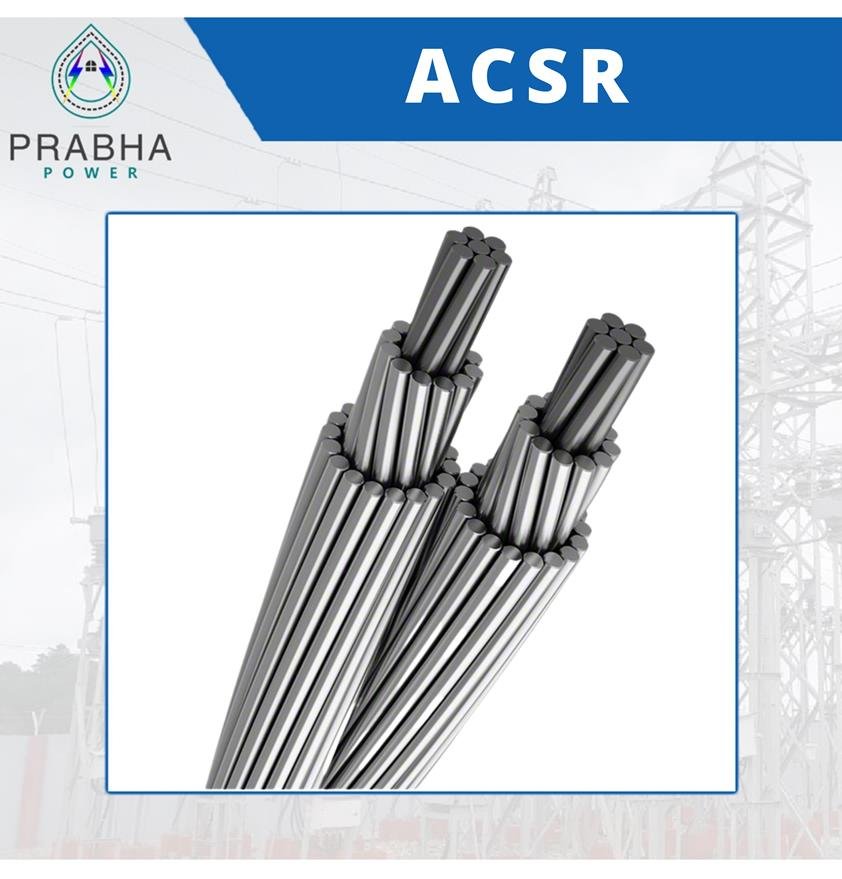ACSR Conductor: Types, Functions and Its Advantages
ACSR conductors play a crucial role in the transmission and distribution of electrical power. Overhead power lines are what keep electricity flowing from power plants to substations to eventually power our homes and businesses. But what makes these transmission and distribution lines actually work? The conductors of course! Aluminium conductor steel reinforced (ACSR) cables have been the workhorse conductors used on overhead power systems around the world for decades.
In this in-depth blog, we’ll explore ACSR conductors and what makes them so popular and well-suited for overhead power transmission applications. We’ll also look at the different types of ACSR cables, their key functions and capabilities, and the major benefits they offer compared to other conductor options. Let’s get started!
What are ACSR Conductors?
ACSR conductors, or Aluminum Conductor Steel-Reinforced cables, are a specialized type of electrical conductor used for overhead power transmission lines. They consist of stranded aluminium wires wrapped around a galvanized steel core. The aluminium provides high conductivity for efficient electricity flow, while the steel core adds tensile strength to withstand the weight and tension of long spans between transmission towers.
Types of Aluminium Conductors
There are a few main types of Aluminium Conductors to know:
Aluminum Conductor Steel Reinforced (ACSR): The most popular and widely used type. It consists of aluminium conductor strands wrapped around a core of steel for strength. The aluminium efficiently conducts electricity while the steel core adds mechanical strength.
Aluminum Conductor Steel Supported (ACSS): Similar to ACSR but with the steel strands on the outside to act as a support. Can be used when less reinforcement is needed.
Aluminum Conductor Composite Core (ACCC): Uses carbon and aluminium composite cores instead of steel for greater efficiency and capacity. But more expensive.
Aluminum Conductor Composite Reinforced (ACCR): Hybrid of ACCC and ACSR with aluminium composite core and outer steel reinforcement. Gives strength plus higher capacity.
So in summary, traditional ACSR uses a steel core while newer composite conductors substitute the steel for carbon materials. However steel-reinforced ACSR remains the most cost-effective option.
Key Functions and Capabilities
Now that we’ve looked at the different types, let’s examine the key functions and capabilities that make ACSR conductors so versatile and reliable:
- High Conductivity – The aluminium alloy used in ACSR is highly conductive to minimize power losses during transmission over long distances. Aluminum has a conductivity of approximately 60% that of copper but at a fraction of the weight and cost.
- Durability – The steel core grants ACSR tremendous mechanical strength and reinforcement. It can reliably withstand heavy wind, ice and debris impacts. Steel has a much higher tensile strength than aluminium.
- Flexibility – The stranded construction with individually wrapped aluminium and steel wires allows ACSR cables to be bent, twisted and coiled during installation. It’s much more flexible than solid conductors.
- Temperature Resilience – ACSR’s aluminium and steel maintain their strength and integrity across a wide temperature range from -50°C to over 150°C. Suitable for all climate conditions.
- Weather/Corrosion Resistance – Aluminum forms an outer oxidized layer when exposed to air. This protects the conductor from corrosion. Galvanized steel also enhances weatherability. Special ACSR coatings are available when needed.
ACSR conductors essentially combine the best properties of aluminium and steel into a single high-performance cable. The aluminium gives you very good conductivity and current capacity, while the steel grants mechanical ruggedness and support for overhead installations.
Advantages of ACSR Conductors
Now let’s explore the biggest advantages of using ACSR conductors for power transmission applications:
- Cost Savings: The aluminium in ACSR provides high conductivity at a fraction of the cost of solid copper conductors. Aluminium prices have also remained relatively stable over decades. This makes ACSR an economical choice.
- Light Weight: Aluminium has a density of approximately 1/3 that of copper. This results in a lower weight per unit length of ACSR versus copper cables. So ACSR requires fewer support structures and reduces installation costs.
- High Capacity: The conductivity of aluminium combined with the availability of large diameter wires enables ACSR conductors to carry huge amounts of current – over 3000 amps for the largest sizes. Suitable for high voltage transmission up to 500 kV.
- Low Line Losses: The high conductivity of aluminium minimizes resistive losses along the cable run, resulting in very low line losses even over distances of hundreds of miles. This improves transmission efficiency.
- Long Spans: The high strength provided by the steel reinforcement allows ACSR conductors to be strung across very long spans between towers, further reducing installation costs. Spans over 500m are possible.
- Reliable: Properly installed ACSR conductors have a typical lifespan exceeding 40 years. The steel core maintains tensile capacity even after years in service. Just occasional maintenance is needed.
ACSR conductors offer an ideal balance of electrical conductivity, mechanical strength, all-weather durability and affordability. That’s why they are the first choice for overhead high-voltage power transmission across the globe.
Typical Applications
Here are some of the most common applications where ACSR conductors are used:
- Overhead transmission lines up to 500 kV
- Electrical distribution systems up to 34 kV
- Feeders connecting substations, switchyards and transformers
- Bridging across rivers, valleys and highways
- Public utility distribution poles
- Any overhead wire application requiring high strength!
ACSR conductors are available in a wide range of conductor sizes and voltage ratings to suit everything from rural distribution to ultra-high voltage transmission trunk lines. Contact the power cable experts at Prabha Power to determine the optimal ACSR cable for your application’s voltage, current and physical span requirements.
Conclusion
ACSR conductors are integral components of overhead power transmission and distribution systems. Their excellent electrical conductivity, high tensile strength, and other salient features make them reliable and efficient in various environmental conditions. As a leading provider of HT and LT cables & conductors, Prabha Power understands the importance of utilizing high-quality conductors like ACSR to ensure a safe and reliable power supply across Northeastern States.
The combination of lightweight, high strength, all-weather durability and cost efficiency makes ACSR the workhorse conductor for overhead power lines. We hope this overview has provided insight into the different types of ACSR cables and their many advantages for power transmission. Let us know if you have any other questions!

